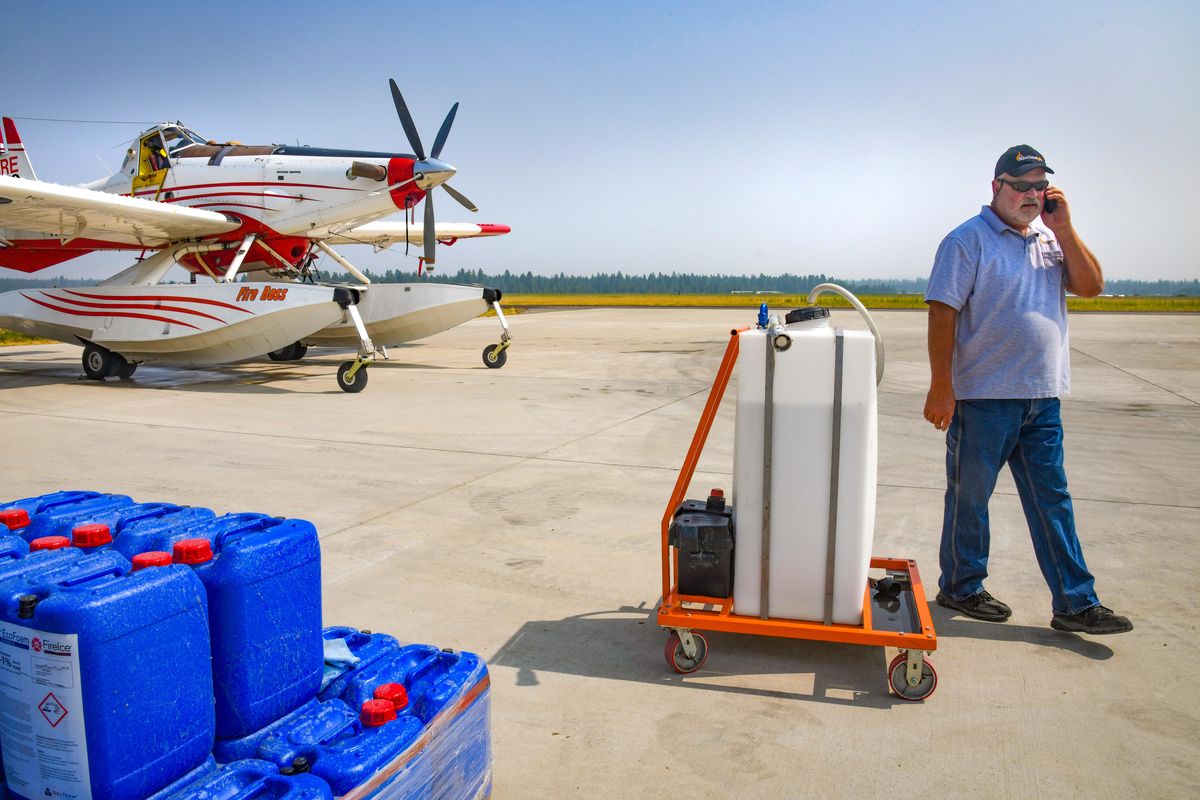Deer Park company manufactures ‘super water’ to help fight wildfires

Holding a plastic cup of cream-colored gelatinous goo, Harlan Johnson stuck his pointer finger and thumb into the mix, twirled them around, and rubbed them together.
“Slippery,” the 61-year-old semi-retiree said. “But completely natural.”
The general manager and vice president of Australian-born G5 BioSolutions was talking about his company’s prized product – the practically named Blaze Tamer 380. It’s a polymer that, when added to water, toys with molecules, thickens things up and transforms boring blue H2O into a slippery super water better suited for putting out fires.
“This stuff, it pulls out so much more fire,” said Johnson. “It’s better water.”
For close to three years, the now Deer Park-based company has been shopping Blaze Tamer 380 around to states and fire districts across North America. Last year, the company found a permanent home north of Spokane after its product saw a summer of heavy usage, called into action as fire crews battled blazes in Washington and Idaho.
This year, Blaze Tamer 380 has rained from above closer to home. It came into play just last month, during July’s Upriver Beacon fire, which nearly swallowed hundreds of homes as it made its way up to the populated Beacon Hill northeast of the city.
Johnson credited the lack of residential damage to fast work by area firefighters. But he said the synthetic super water played a role as well.
“A lot of what we’re doing is changing hearts and minds,” he said Wednesday afternoon at G5’s warehouse at the Deer Park Airport, to the backdrop of wildfire smoke and the buzz of planes taking off. “We’re changing tactics.”
Unlike fire retardants, which are dropped only where the fire is headed, Blaze Tamer 380 goes where the fire is, just like regular water. And one of the inherent problems with normal water, Johnson said, is that when it’s dropped several hundred feet in the air – oftentimes in a strong crosswind – the liquid dissipates and spreads before it has a chance to hit the hot stuff.
Blaze Tamer, however, makes water thicker, and slippery. It not only coats the objects it touches and takes more heat from the fire, the company says, but when dropped from the air, it globs together and falls in a more uniform stream.
“It just adds a weight to the water,” Johnson said.
Michael Cuthbert, an aviation program manager at DNR, said the state was drawn to the product last year almost out of necessity, especially in northern and Eastern Washington, where wildfires can ravage hundreds of thousands of acres of land, oftentimes near populated areas.
“With climate change, you can argue all day about why it’s happening. But the fact is it is happening,” he said. “We’ve basically recognized that we have to be a little more aggressive in what we do.”
One of the biggest draws, Cuthbert said, was Blaze Tamer’s unique ability to be mixed with each load of water dropped from a DNR modified Air Tractor AT-802, or Fire Boss, plane – not just on the first run like other products and retardants. By adding the enhancer to the water in-air, pilots can simply scoop water into the 800 gallon tank from a nearby source and drop it with Blaze Tamer added, rather than having to land and refill a tank.
And since it’s added mid-flight, the company says there’s no chance of it seeping in to water sources.
Johnson said to reach maximum firefighting efficiency, about six and a half gallons of Blaze Tamer is needed per 1,000 gallons of water. For a typical run in a Fire Boss, that’s about eight drops with Blaze Tamer, and another two to four with water before the plane needs to refuel.
With a cost of about $1 per gallon, compared to that of retardants, which can run at twice that rate, it’s cheaper, too. Cuthebert noted the state doesn’t actually drop retardant from state-owned planes – rather it comes in through federal planes or from other states. He cited environmental concerns as a chief issue.
G5 claims Blaze Tamer is biodegradable within 60 days of use, and unlike retardants, the main ingredient is naturally occurring. Johnson said it’s also noncorrosive and nontoxic to animals and humans, though it’s not recommended for prolonged exposure, according to its material safety data sheet.
When Commissioner of Public Lands Hilary Franz was elected in 2016, Cuthbert said she came in to office with an emphasis on protecting the environment from firefighting efforts. So when DNR was approached by G5, both organizations say it was a win-win.
“She’s kind of made it clear to all people in the organization that we will abide and strive and always improve our position with doing things to the environment that could be harmful,” he said. “That’s another reason why this Blaze Tamer was chosen.”
According to the product’s website, it also meets USDA Forest Service requirements and is used in Australia and New Zealand. It has not yet been approved for federal firefighting use.
Still, Johnson estimates about 15,000 to 16,000 gallons of the enhancer have been dropped this year nationwide – about a 100-percent increase from last year.
“At the end of the day, we’re putting out fires,” the retired firefighter said. “Cool beans.”